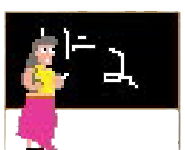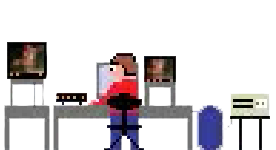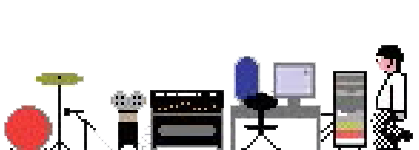David Linton (born Newburgh NY 1956) is a Temporal Media artist
traveling the vectors of sound, light, subculture, media ontology, and signal flow.
Since his arrival upon the downtown NYC experimental arts scene at the end of the
1970’s Linton has consistently sustained a multi-faceted reputation as an innovative
and influential collaborator as well as a driven solo performer over the course of
this 30+ year period. With his arrival in NYC as a hi energy punk era trap set
drummer with attitude to spare – after his mid 70’s student days devoted to
exploring experimental film under the primary formative if unsettling influence of
american avant gard legend Ken Jacobs – Linton rapidly developed an innovative
personalized approach to producing hybrid musical/sound scores for the many
collaborative dance, theater, & performance contexts his life in the downtown milieu
of the day provided (realizing notable and in some cases award winning works with
‘punk’ ballet diva Karole Armitage and theatrical art stars the Wooster Group for
example… all the while maintaining his stride as a drummer “in demand”. Within this
decade filled with a good deal of touring and recording percussion work among fellow
musicians: Lee Ranaldo, Rhys Chatham , Glenn Branca, Elliott Sharp, Zeena Parkins
and others – he would soon become equally well known for high energy improvised solo
performances on his hand built early hybrid electro-acoustic drum kit upon which he
would erect spectacular spontaneous architectural monoliths from piecemeal slabs of
analog sound triggered in time by each and every contact miked drum hit – as well as
for his marginally more relaxed & explorative soundscape productions usually
rendered to tape for theatrical playback . In 1986 a studio expansion of his live
drum/trigger approach led to an elite edition solo Lp “Orchesography” (issued on
vinyl only for Glenn Branca’s “Neutral Records” label) which delivered an unlikely
collusion of distorted classical motifs, street beats, & slabs of early sampling tek
noise – all intermingling in a context derived from the theatrical post modernism
indigenous to the downtown arts environment of the day – to a not yet entirely
‘tuned in’ public. By the turn of the decade Linton felt compelled to move on –
leaving the drum kit and physical percussion behind – to explore new tools… By 1990
David had for the most part withdrawn from performing in the live percussion vein to
concentrate on the vocabulary of entirely electronic music and the resultant
paradigm shift in performance priorities that this new ‘compressed’ format demanded.
*With a couple of notable exceptions: In 1991 David briefly took up sticks to attend
to percussion duties required by Diamanda Galas’ Plague Mass as incarnated at the
Cathedral of St John the Divine, NYC and subsequently recorded and released by Mute
records * Once a drummer always a drummer… yet it was the technologically mediated
aspect that had deeply insinuated itself in Linton’s work over the course of it’s
first decade which was destined to stay nearest at hand in the core of all
subsequent work. Throughout the 90’s Linton became an ever more dedicated advocate
for the expansion and appreciation of realtime performance in electronic media
through the production & design of (often ‘underground’) event/environments such as
‘SoundLab’ (1996) and eventually ‘UnityGain’ (1997-2008). From 2001 Linton’s
fascination with instantaneous collaborative audio visual communication among select
units of electronic sound and projection artists assumed the form of a live
experimental television Manhattan cable TV/webcast project – UGTV – Unitygain
Television (2001-2004) – for which he was the curating producer/ director working in
conjunction with DCTV (downtown community television center) and MNN (manhattan
neighborhood network) and a crew of graduate design students from the Parson’s
School of Design ‘digital’ department to present live in studio performances from
some the finest electronic innovators on the NY audio visual scene mixed live to
cable TV uplink… While this period proved to provide fertile ground for imminent
development in areas that had remained dormant in Linton’s work – primarily those
dealing with visuality in conjunction with aurality – it did for some time deflect
his energy vector as a solo performer in favor of the more organizational role of
curator / director / producer while at the same time allowing for some new growth
and focus upon overall design parameters that would soon prove to be useful in the
next phase of his own realtime media based Art. In 2003 David was invited to curate
the Roulette Mixology Festival which convened at the Performing Garage in June… this
proved to be a concentrated who’s who of the NYC multimedia arts of the day… By 2004
David had embarked upon his present course with the launch of his first solo
audio-visual project. Having by this time tired of the reductive micro clime of the
digital audio work process Linton was drawn back to the basic energies of analog
processes via a simple hack he devised to cross patch analog audio and video signals
driven by sine tone oscillators combined within closed circuit rescan feedback loop…
This primitive hack formed the basis of a system he would soon develop into a quite
effective live performance vehicle which he christened “the bicameral research sound
& projection system” Some history of the project can be found here: With his
“Bicameral Research Sound & Projection System” (2004) Linton has aimed to make
vibrational wave induced perceptual energy states manifest via the deployment of
interconnected proportional measures of electric sound & pulsing light in live
action with hand manipulated objects in physical (live camera) space. Employing an
integrated recursive audio & video feedback system of his own perversely simple
design modulated by freehand intervention he delivers a vigorous eye, ear, and –
sometimes – body shaking realtime audio visual performance from which a kind of
retro-tech animist ritual “medicine show” emerges where subject and object blur.
Thematically David likes to consider that within the 20th Century 60 Hz alternating
electrical current gradually came to function as a primary subliminal Prana in the
mass bio-energetic body/culture of human life in North America… Indeed many of
Linton’s live performances in recent years have featured guest musicians intoning on
top of the line buzz of the NTSC video standard commenced under the title “60Hz
Raga”. When combined with the fundamental subharmonic visual ‘Flicker’ rate we have
the raw material of Linton’s “Cortical Degausser” installation. Linton’s Cortical
Degausser Installations are a distillation of forces explored in his Live
Performance work. The Cortical Degausser is a site-specific Intermedia installation
in which visitors experience pulsating harmonic bands of colored light Flicker and
generative synchronous sound Drone ( in a fundamental frequency range of 10 to 20 Hz
) delivered via video signal that is in turn mediated by diffusion screens
refracting the video information back into the realm of pure Light. The immersive
relational environment thus established stimulates neurological mechanisms within
the viewer’s own visual cortex that trigger the spontaneous display of self
animating geometric patterns which appear to hover in space in front of the
subject’s field of vision even with eyes open. Recently quite a bit of new
information has been accruing around the subject of Flicker and the neurological and
cultural implications of the geometric patterns and forms it induces in almost all
‘normal’ human subjects.





